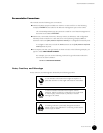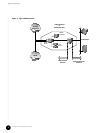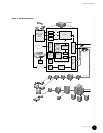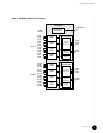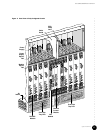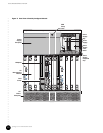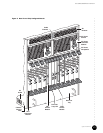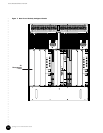
•
•
•
•
•
•
•
•
•
•
•
•
•
•
•
•
•
•
•
•
•
•
•
•
•
•
•
•
•
•
•
•
•
•
•
•
•
•
•
•
•
•
•
•
•
•
•
•
•
•
•
•
•
•
•
•
•
•
System Overview
G10 CMTS Features and Functions
7
G10 CMTS Features and Functions
The G10 CMTS provides true multiservice support, including the ability to simultaneously
support DOCSIS IP services and VoIP services.
Functional Overview
The G10 CMTS is usually connected directly to a Gigabit-class core router that is part of a
multiple system operator’s (MSO) metropolitan core network. It receives network-side packet
streams originating from the Internet, Media Gateways or video servers, then processes them
into DOCSIS-compatible digital signals (MPEG) that are modulated onto an RF carrier for
transmission downstream over the HFC network to the subscribers’ cable modems.
Upstream signals consist of protocol data units (PDUs) in data bursts from the cable modems.
The G10 CMTS uses advanced scheduling algorithms to optimize the timing of these
transmissions. The packets are processed to recover the payload data, then routed, as IP
packets, to the appropriate destinations through the network-side interface.
The G10 CMTS’s high capacity of up to 32 downstream and 128 upstream interfaces and
other innovative features are provided by the Broadband Cable Processor ASIC
(application-specific integrated circuit).
Broadband Cable Processor ASIC
The Broadband Cable Processor ASIC provides all-digital processing of the return path. This,
plus advanced noise cancellation and equalization algorithms, enables modulation rates
beyond QPSK and allows traditionally problematic frequency ranges of the upstream
spectrum to be utilized. All-digital processing also accommodates full spectrum analysis by
capturing statistics of the upstream band in real time.
The Broadband Cable Processor ASIC incorporates key DOCSIS MAC (media access control)
functions such as concatenation, fragmentation, encryption, and decryption. Accelerating
these functions in hardware provides a high-performance, scalable CMTS solution that can
process thousands of simultaneous DOCSIS service flows.
Advanced timing and digital signal processing algorithms allow more efficient use of the
RF spectrum, resulting in increased channel capacity.



